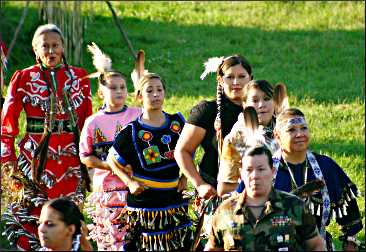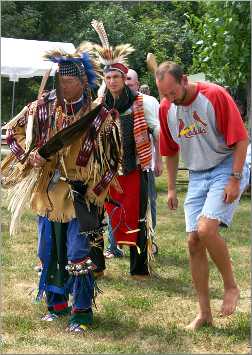Ojibwe or Chippewa, Dakota or Sioux?
Here's what you need to know about the Upper Midwest's indigenous people.

© Beth Gauper
Wisconsin and Minnesota have two main tribes. The Ojibwe migrated from the east along the Great Lakes, pushed by newly arrived Europeans and other tribes.
With the help of guns acquired in the fur trade, they pushed the Dakota south and west in the 18th century and replaced them in the north woods.
The Dakota are thought to be descendants of the Woodland Indians who built effigy mounds in the Upper Midwest. Today, they live in small communities along the Minnesota and Mississippi river valleys and in South Dakota.
Nationally, the Ojibwe and Dakota are the third- and fourth-largest Indian nations.
Sometimes, tribal names cause confusion. The Ojibwe's name was shortened into Chippewa by French traders, and Chippewa still is the legal name of many bands, especially in Wisconsin.
The name Anishinabe, or "the original people," has spiritual meaning and is what one Ojibwe calls another.
The term Ojibwe is used most often when referring to tribal culture and tradition.
The term Dakota-also Lakota, on the prairies farther west-is the tribe's own word for "allies." But historically, they have been known as the Sioux, a word thought to have come from the French-Canadian nadouessioux, derived from an Ottawa word for "little snakes."
Although the name Sioux was meant to be derogatory, it has become associated with courage and bravery over the years, and many Dakota, especially elders, still bear it proudly.
Many non-Indians think they should use the term "native American" when referring to the indigenous people of the United States, but many tribal members prefer "Indian" if an umbrella term must be used.
In Canada, the umbrella term is "aboriginal," and communities are called "first nations."
But since people in both countries consider themselves members of separate nations rather than a common race, it is best to use tribal affiliations, such as Dakota or Ojibwe, whenever possible.
How the Indians lost their land

© Beth Gauper
When French fur traders arrived in the Upper Midwest in the 17th century, the land belonged to the Ojibwe, the Dakota and many other tribes — except they did not believe land could be owned by individuals or transferred by a piece of paper.
This fundamental difference in perception colored agreements between Indians and Europeans for the next two centuries.
In the beginning, when land was plentiful, the newcomers took the high road: The 1787 Northwest Ordinance stated, "The utmost good faith shall always be observed toward Indians; their land and property shall never be taken from them without their consent; and in their property, rights and liberty, they shall never be invaded or disturbed . . . "
But when the Europeans needed land, they took it. In 1830, President Andrew Jackson's Indian Removal Act shoved Indians west of the Mississippi River and out of Missouri, Arkansas and Louisiana.
In 1854, the Indian Appropriations Act gave Congress authority to establish Indian reservations. In 1862, the Homestead Act unleashed a stampede of settlers, who swarmed to Indian lands and increased pressure for treaties.
By 1887, even the land Indians held on reservations seemed like too much, and the Indian Allotment Act eliminated the rights of Indians to hold tribal land in common.
Their reservations were taken away and exchanged for allotments of 160 acres per head of household, 80 acres for a single person.
Many Indians, unable to make a living, eventually sold their land to white people. The reservation land that was left over — 90 million acres — also was sold.
Between 1829 and 1833, the Winnebago (Ho-Chunk) and Potawatomi ceded their land in southern Wisconsin. At the same time, the Menominee were ceding eastern Wisconsin.
In 1837, the Santee Dakota gave up their land in western Wisconsin. The same year, the Dakota and Ojibwe lost most of their land east of the Mississippi. In 1851, the Dakota, under duress, signed away most of southern Minnesota.
Each chief also had to sign a "trader's paper," whose inflated demands and kickbacks nearly equaled the amounts the Dakota were to receive under the treaty.
This plundering was no secret at the time. As Episcopal bishop Henry Whipple, a friend of the Dakota, later noted, "The treaty is usually conceived and executed in fraud. The ostensible parties to the treaty are the government of the United States and the Indians; the real parties are the Indian agents, the traders and politicians."
By 1854, the Ojibwe had been forced to cede most of northern Minnesota and Wisconsin, including their sacred homeland on Madeline Island in Lake Superior.

© Beth Gauper
In Minnesota, the Dakota were confined to a 10-mile-wide strip south of the Minnesota River by 1858. After the War of 1862, they lost even that and were banished from the state.
Some Indians refused to go. Forcibly removed in 1840, Ho-Chunk leader Yellow Thunder came back in 1849 and bought 40 acres in the Wisconsin Dells, the Ho-Chunk homeland.
It served as a haven for the Ho-Chunk until 1875, when amendments to the Homestead Act allowed them to file claims and resettle in the area.
The Dakota started drifting back to Minnesota in the 1880s, and eventually the U.S. government purchased small reservations for them at Prairie Island, near Red Wing; at Shakopee, just west of the Twin Cities; and at the Upper and Lower Sioux Agencies along the Minnesota River.
The Minnesota Ojibwe have much larger reservations: White Earth, in the northwest, the largest; Red Lake, north of Bemidji; Leech Lake, around Walker; Bois Forte, south of International Falls; Grand Portage, at the far tip of the North Shore; Fond du Lac, west of Duluth; and Mille Lacs.
In northern Wisconsin, the Red Cliff, Bad River, Lac Courte Oreilles, Lac du Flambeau and Mole Lake bands of Ojibwe have reservations, and the St. Croix have scattered parcels.
In southern Wisconsin, the Stockbridge-Munsee Mohicans, Potawatomi, Oneida and Menominee have reservations, and the Ho-Chunk have scattered settlements.
The Menominee, who had built a self-sustaining timber operation on their reservation, were targeted for termination under new federal policy in 1953 and lost their reservation in 1961.
In 1973, after extensive litigation, their tribal status and land were restored.
Most of the reservations were turned into checkerboards when owners of allotted land were forced to sell. Today, whenever possible, tribes buy the land back from white owners.
Here's a map of the original native lands.
For more about indigenous cultures in the Upper Midwest, see Heritage travel: Dakota and Ojibwe.
Here is more about tribal lands in Wisconsin.